
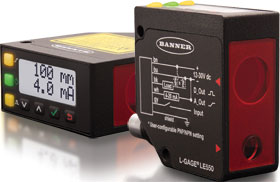
New from Banner Engineering is the LE550 laser measurement sensor designed with linear array technology and featuring a visible, class 2 red laser beam. The non-contact laser sensor provides high repeatability and accurate measurement for challenging targets ranging from shiny metal to black rubber. With easy, ready to use operation, the LE550 comes calibrated for 100-1000 mm range out of the box, making it an ideal detection solution for diverse measurement applications including roll diameter, loop control, thickness measurement and positioning.
Featuring an intuitive two-line, eight-character LCD display, the LE550 makes adjustment and menu navigation simple, even for the first time user. In ‘run mode’ the top line of the display indicates in real time the distance measured in millimetres, while the bottom line indicates the analogue output value, in milliamps or volts, dependent on model. All models also feature a discrete (switched) output. The discrete output is independent of the analogue output and can be programmed to be PNP or NPN.
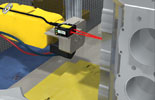
Programming
Programming the sensor is achieved in one of two ways, either by using the buttons on the top or by remote wire input. The buttons on the sensor can be disabled to prevent tampering with the settings and both the analogue and discrete outputs can be set independently over the sensing range. The 4-20 mA (or 0-10 V) analogue output can be programmed to be anywhere within the sensing range, with a minimum distance of 10 mm. For example, it is possible to set the sensor up to have a window of 10 mm at 500 mm from the sensor face. The analogue output would then be linear over the selected range: output will be 4 mA with a target at 495 mm and 20 mA with the target at 505 mm. The slope of the analogue output can be adjusted to be either positive or negative. The discrete (switched) output can be set up in a similar way and has the additional feature of timing functions (on delay, off delay or a one shot function). As mentioned the discrete and analogue outputs are totally independent of each other and can be individually programmed, however, if required, they can be set for the same distance functions. Another programmable feature is the outputs response in the case of loss of signal. It can be programmed to go low, high or retain the current value of the outputs.
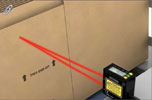
Operations and application
Laser triangulation sensors provide a non-contact measurement solution for accurate measurement of moving or soft targets without causing damage to the sensor or the object. The linear array technology incorporated in the LE550 provides excellent consistency in measurement across different targets. For example, the unit boasts a resolution of 0,5 mm in the sensing range 100-600 mm and then 1 mm up to the 1000 mm maximum range. Accuracy in the 100-600 mm range is ±2 mm. For optimal use in demanding environments, the LE550 is enclosed in a rugged zinc housing that includes a polycarbonate lens cover rated to IP67. All models meet Military Standard 202G requirements in addition to IEC 60947-5-2, to withstand applications subject to vibration or shock. Popular applications include:
* Roll diameter of various materials, typically where the diameter is needed in a feedback circuit to control the turning speed of the roll.
* Loop control, where the speed of material between different sections of a machine is controlled.
* Thickness or height measurement.
* Part identification.
* Positioning.
* Part in place verification.
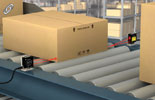
Practical examples
Inspecting small connectors from one metre away
An automotive supply company makes seating systems that combine structure and design with features that enhance comfort and safety. Weight sensors installed on the underside of the seats work in coordination with vehicle safety systems to determine the size and position of a seat occupant. These factors affect how, or if, airbags will be deployed in the event of an accident.
To work properly, the weight sensor connector on the underside of the seat cushion must be fully inserted. If it is not, airbags will not deploy appropriately in an accident. These systems, which cannot be used by the vehicle manufacturer, get returned for repair. The difference between a fully inserted connector and one that is not is a distance of 4 mm. The company wanted to implement an automated inspection system that would verify that weight sensor connectors were properly installed prior to being shipped.
The company chose Banner’s L-Gage LE550 to verify that seat weight sensor connectors are fully inserted. Deployed alongside the assembly line, the sensor targets the back of the weight sensor connector. The visible beam and small spot size made it easy to align and the LCD display greatly simplified setup. To ensure unimpeded travel on the conveyor, the LE550 is located 500 mm from the target. From this range, it is capable of recognising changes in distance as slight as 0,5 mm. As the seat passes by, the sensor measures the distance between it and the back of the connector. If the connector is measured at a distance less than 500 mm an alarm notifies the operator and the line is briefly stopped. The operator can then correct the problem while it is easy to access the connector.
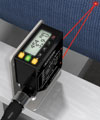
Laser sensors measure paper rolls in a range of colours and automatically scale output
A manufacturer of table top products offers paper table coverings in many styles and in a broad range of colours. Prior to being packaged, paper table coverings are unwound from large rolls and cut to size. Insufficient or excessive tension on the paper can damage the coverings, making them unsellable. To maintain the proper level of tension, the unwind speed needs to increase proportionately to the shrinking size of the roll.
Because of their immunity to variations in colour, ultrasonic sensors were used to take continuous measurements of each roll’s diameter and regulate unwind speeds. However, gusts of air passing through the production area caused measurement errors which led to disproportionate unwind speeds.
Product losses and downtime prompted the company to seek an alternate solution. In testing, optical sensors were unaffected by the gusts, but darker collared table coverings were difficult for the sensors to measure, resulting in incorrect outputs.
After a convincing demonstration, the company chose Banner’s L-Gage LE550 laser gauging sensors to replace the ultrasonic sensors on their winders. Like the optical sensors, the LE550 is unaffected by drafts in the facility. But, unlike the optical sensors, it is colour insensitive. Linear array technology enables the laser sensor to measure each roll regardless of paper colour, even the colours that had most challenged the optical sensors. The superior linearity, repeatability and resolution of the LE550 ensure reliable and consistent roll measurement and output.
Using the default settings, the company deployed sensors throughout the facility without having to teach or scale the outputs. Out of the box, the LE550 automatically scales across its entire operational range, from 100-1000 mm. The LCD display provides real-time measurement and output information and makes it easy for the company to assign set points and output levels.
For more information contact Rodney Topham, RET Automation, +27 (0)11 453 2468, [email protected], www.retautomation.com
| Tel: | +27 11 453 2468 |
| Email: | [email protected] |
| www: | www.turckbanner.co.za |
| Articles: | More information and articles about Turck Banner Southern Africa |

© Technews Publishing (Pty) Ltd | All Rights Reserved